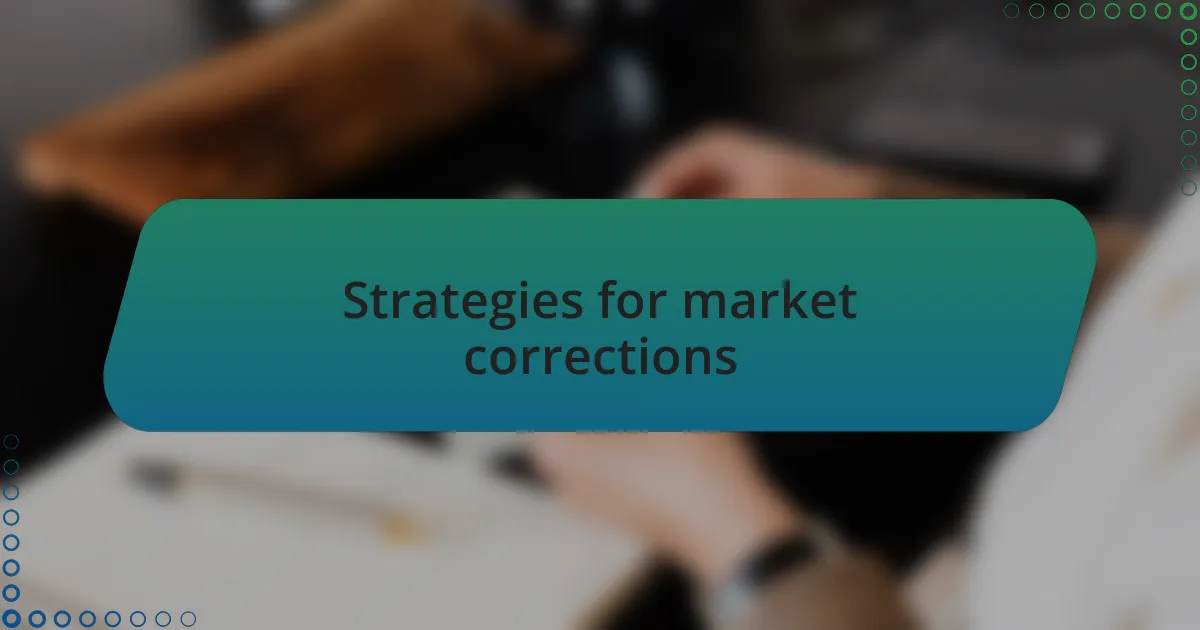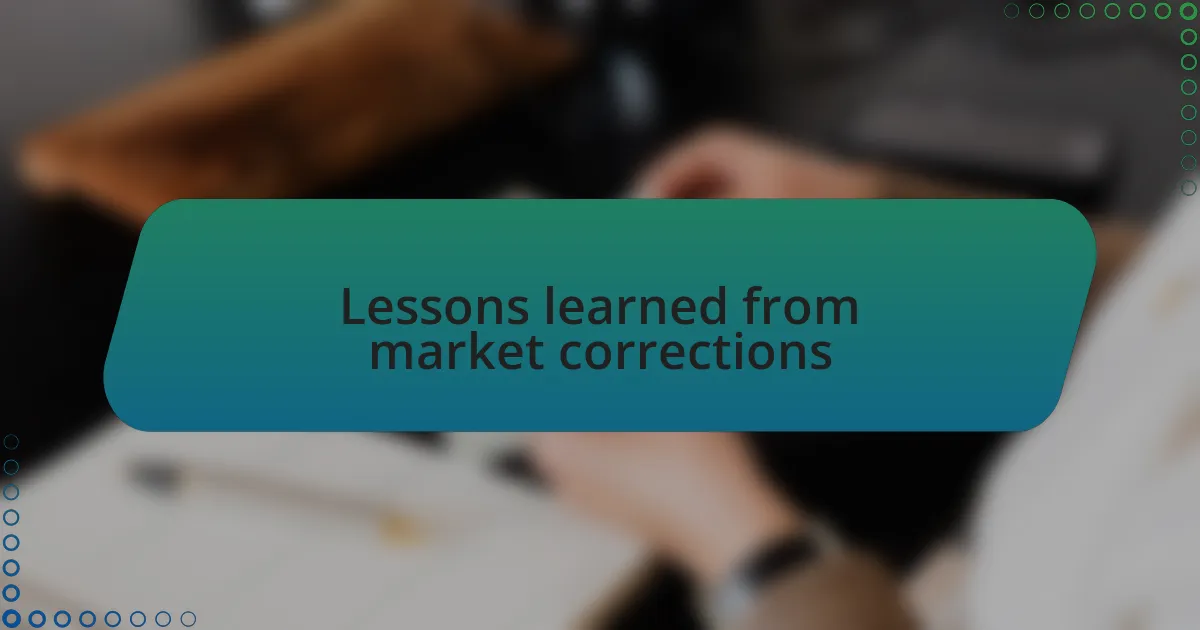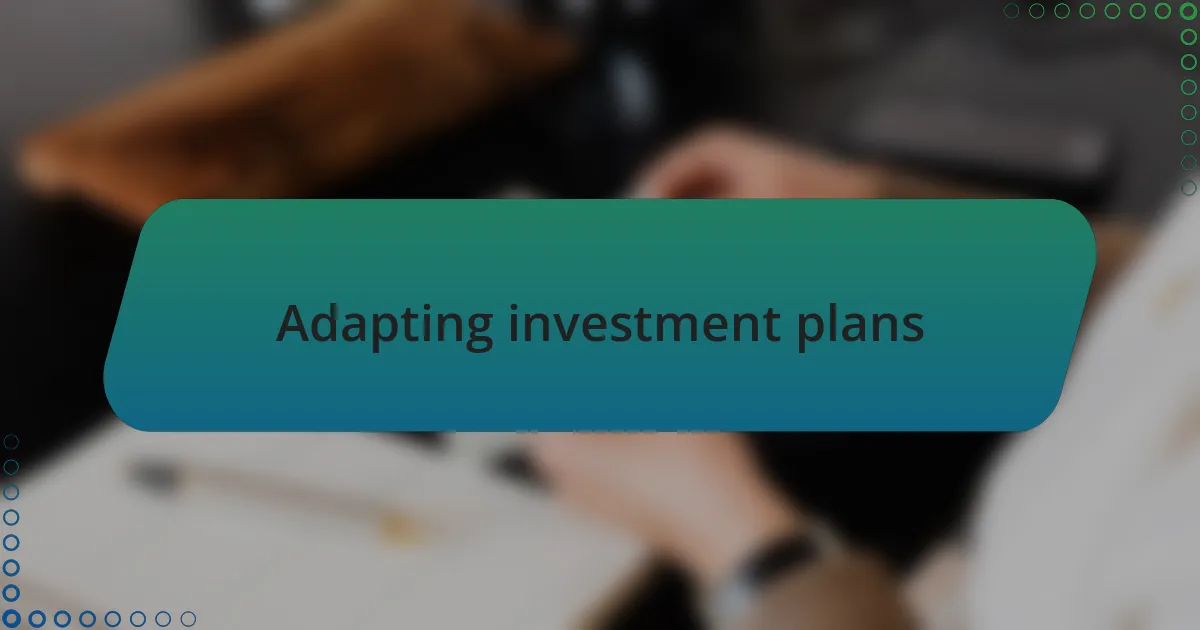Key takeaways:
- Market corrections, defined as declines of 10% or more, are normal and can provide buying opportunities for informed investors.
- Investment consulting is crucial during corrections, helping investors maintain confidence and focus on long-term goals.
- Diverse portfolios and maintaining cash reserves are effective strategies for navigating market fluctuations.
- Adapting investment plans with flexibility and periodic reviews can enhance resilience and decision-making during market volatility.

Understanding market corrections
Market corrections can feel like a turbulent ride on a roller coaster. I remember facing one during my early investing days and feeling that nagging anxiety in my stomach—was my portfolio in ruins? Understanding that a market correction is typically defined as a decline of 10% or more from a recent peak can help put those fears into perspective. This fluctuation is not a signal of disaster; rather, it’s a natural part of the market’s ebb and flow.
Have you ever wondered why these corrections happen? From my experience, they often result from various factors, such as shifts in economic indicators, changes in investor sentiment, or geopolitical events. I recall a specific instance where a sudden political announcement shook the market. I had to remind myself that while it felt unsettling in the moment, such corrections can often create buying opportunities for those who remain calm and informed.
Reflecting on how I navigated a market correction, I learned that patience is key. In one instance, rather than panicking and selling off my investments, I chose to view the situation critically. I analyzed my portfolio and used this time to adjust my strategy, focusing on long-term growth instead of short-term losses. This realization not only bolstered my confidence as an investor but also deepened my understanding of market behavior as a whole.

Importance of investment consulting
Investment consulting plays a crucial role during market corrections, providing investors with clarity in turbulent times. I remember when a sudden downturn hit; I felt lost until my advisor guided me through the noise. This support helped me understand that having an expert by my side can transform uncertainty into confidence, allowing me to make informed decisions.
When I faced my first major market correction, I realized how essential it was to have a consultant who could analyze my investment strategy with a critical lens. They didn’t just offer reassurance; they helped me explore adjustments that aligned my portfolio with my long-term goals while taking advantage of the lower market prices. Imagine navigating those choppy waters alone—wouldn’t that feel daunting?
The importance of investment consulting becomes even more apparent when emotions run high. It’s easy to let fear dictate decisions, like when I nearly panicked selling in a brief downturn. Instead, my consultant encouraged me to focus on the fundamentals, reinforcing why I invested in the first place. I learned that good consulting isn’t just about advice; it’s about fostering a mindset that views corrections as opportunities rather than threats.

Strategies for market corrections
To navigate market corrections effectively, I’ve found that diversifying my investment portfolio is crucial. It’s not just about having a mix of assets; it’s about strategically distributing risk across various sectors. I recall a time when I diversified into bonds during a stock market slump, which cushioned the impact and provided stability while equities were volatile. Have you considered how diverse your investments really are?
Another strategy that has proven beneficial is maintaining a cash reserve. This approach allows for quick opportunities when the market dips—like snagging undervalued stocks. During a previous market correction, I was able to capitalize on sudden price drops because I had liquidity on hand. It taught me that having cash isn’t just a safety net; it’s a tool for seizing opportunities.
Lastly, sticking to a predefined investment strategy, especially as markets fluctuate, is vital. I vividly remember a tempting moment when news headlines urged me to abandon my original plan. Instead, I recalibrated my focus on my long-term objectives. Staying disciplined during corrections reinforced my belief that patience and a clear strategy often yield the best results. How often do we let short-term noise drown out long-term vision?

Personal investment experiences
Navigating market corrections has certainly shaped my investment journey. I remember a particularly jarring downturn when fear seemed to grip the markets. Instead of succumbing to panic, I focused on my long-term goals, using that moment to remind myself that investing is not a sprint but a marathon. Did you ever experience a similar pull between fear and faith in your strategy?
There was one instance when I faced a tough decision: to hold on or sell shares during a steep decline. The emotions were overwhelming; I felt both anxious and uncertain. Ultimately, I chose to hold and even buy more of my favorite stocks at lower prices. Looking back, that decision reinforced my conviction in the companies I believed in, ultimately leading to rewarding outcomes. Have you ever had to confront a pivotal moment in your investment journey?
Additionally, I recall attending a seminar on risk management just before a market shift. The insights I gained were invaluable. Learning to evaluate risk not only helped me understand my investments better but also equipped me with a mindset to face corrections confidently. These experiences have taught me that each market fluctuation is an opportunity for growth. How do you approach learning during turbulent times?

Lessons learned from market corrections
Understanding the lessons learned from market corrections has been essential for refining my investment strategy. One significant lesson was the importance of staying informed and adaptable. I vividly remember the panic around the 2020 market downturn, when everything seemed to spiral out of control. In the days that followed, I found solace in diving deeper into market analysis, which allowed me to identify which sectors were resilient. Have you ever taken the time to dissect market shifts instead of reacting impulsively?
I’ve also come to appreciate the value of maintaining a diversified portfolio. After one particular correction, I reflected on how my investments in different asset classes cushioned my exposure to losses. It was a comforting realization when I noticed that my stocks in technology didn’t tumble as severely as those in energy. This experience solidified my belief that diversification isn’t just a buzzword; it’s a crucial strategy in weathering volatility. Do you actively seek balance within your own investments?
Finally, a critical takeaway is the emotional resilience that comes from facing corrections head-on. I’ve discovered that each downturn challenges my strategy and forces me to reassess my risk tolerance. For instance, during a recent dip, I allowed myself to feel the discomfort but used it to reinforce my investment convictions. Embracing this emotional aspect transformed what could have been a paralyzing experience into a stepping stone for better decision-making. How do you process and grow from your own emotional responses during market volatility?

Adapting investment plans
Adapting investment plans requires a willingness to reevaluate priorities, especially after a market correction. I recall a particular instance when my initial strategy heavily favored high-growth tech stocks. As the market shifted, I felt the pull of fear and uncertainty. However, rather than retreating, I decided to pivot. I researched more stable investments, like dividend-paying stocks, which not only provided me with cash flow but also comforted my nerves during turbulent times. Doesn’t the thought of having a safety net resonate with you?
Another time, I faced a decision point when I realized that some of my assets were underperforming in the wake of change. It was tempting to sell everything and cut my losses, but instead, I took a more measured approach. I analyzed the long-term potential of those investments and thought about how they fit into my overall goals. By adjusting my timeline and focusing on the fundamentals, I found renewed confidence. Have you considered how many of your decisions sway under pressure rather than a solid framework?
What stands out for me is the concept of flexibility in investment plans. I’ve learned to set periodic reviews of my portfolio, adjusting keywords like “risk” and “reward” based on evolving market conditions and personal circumstances. For example, during the aftermath of a market hit, I integrated a rule to reassess my investments every quarter. This proactive stance prevented me from becoming too complacent and helped me seize opportunities in unexpected sectors. How do you ensure that your investment strategy remains fluid and responsive?

Tips for future corrections
When it comes to preparing for future market corrections, one of the best tips I can offer from my experience is to build a diversified portfolio. Early in my investing journey, I leaned too heavily on the same sectors, and when those stocks plummeted, I felt helpless. A lesson learned—diversification across various industries and asset classes provides a cushion during volatile times. Have you thought about how varied your own investment mix is?
Another crucial aspect is maintaining an emergency fund that covers your living expenses for several months. In my own case, having that financial buffer allowed me to avoid panic selling during downturns. It felt empowering to know that I had time on my side and wasn’t forced to react impulsively. Does having that safety net give you peace of mind in your investment strategy?
Finally, I can’t stress enough the importance of education and staying informed. After experiencing a correction, I committed to reading more about economic indicators and market trends. This strategy not only boosted my confidence but also made me feel more in control of my decisions. Have you considered the power of knowledge and how it shapes your investment choices?